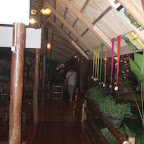Cordillera’s favorite food awaiting patent
Cordillera’s favorite food awaiting patent
BAGUIO CITY—Sagada, the most popular tourist destination in Mt. Province, wants to patent its homegrown etag, an indigenous salted meat dish that is the favorite in almost every ritual feast (cañao) of the Cordillera.
Residents who mount the Etag Festival every February have started the process to acquire the patent for the native way of preparing the delicacy, given the interest it has drawn from people outside the region.
Etag is called kinuday by the Ibaloi and kiniing by the Kankanaey in Benguet, but these tribes have almost similar ways for smoking and curing pork meat in time for their clan festivals.
Some provinces cure their etag by hanging the meat over a raging fire. Other provinces store the meat in earthen jars to stew in its own juice for weeks.
Etag is then boiled in a broth containing vegetables and pinikpikan (native chicken that is killed slowly from the blows of a stick before its skin and feathers are burned in open flame). A slab of etag is sold for P150 per 250 grams in the local markets.
The Highland Agriculture and Resources Research and Development Consortium (Harrdec) in La Trinidad, Benguet, believes there are ways to popularize the delicacy by improving its quality.
Dr. Sonwright Maddul, consortium director, said researchers had drawn up a paper detailing how to make etag palatable as cuisine for non-Igorots.
“When you see a piece of etag, what do you usually think of? It has a foul smell. It is rotten. It is not appealing and it is kadiri (gross) because it has maggots. Even the packaging is not appealing,” he said.
In 2009, Harrdec undertook the project, “Value adding of pork based ethnic delicacy (etag) for commercialization,” which was jointly financed by the Philippine Council for Agriculture, Aquatic and Natural Resources Research and Development and Benguet State University.
Maddul said even the family-cultured meat did not follow a strict code that was handed down by elders. “The procedures, such as salting, smoking, curing and preserving, were just estimations. The quality [of each set of etag] was not consistent,” he said.
“We were motivated to standardize the process of etag preparation [that would pass sanitation rules and culinary taste],” he said.

 Baguio history Arts and Foods
Baguio history Arts and Foods





